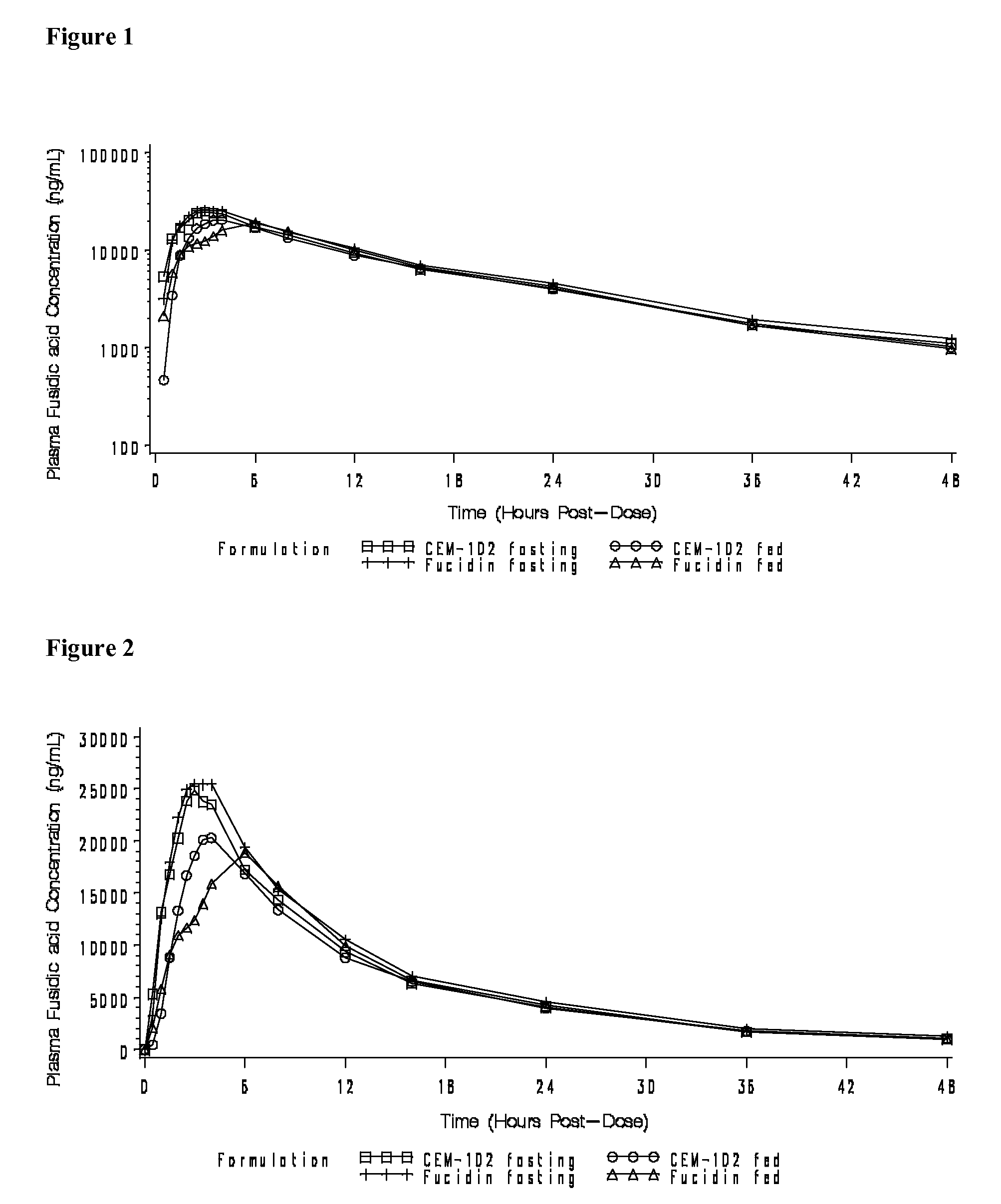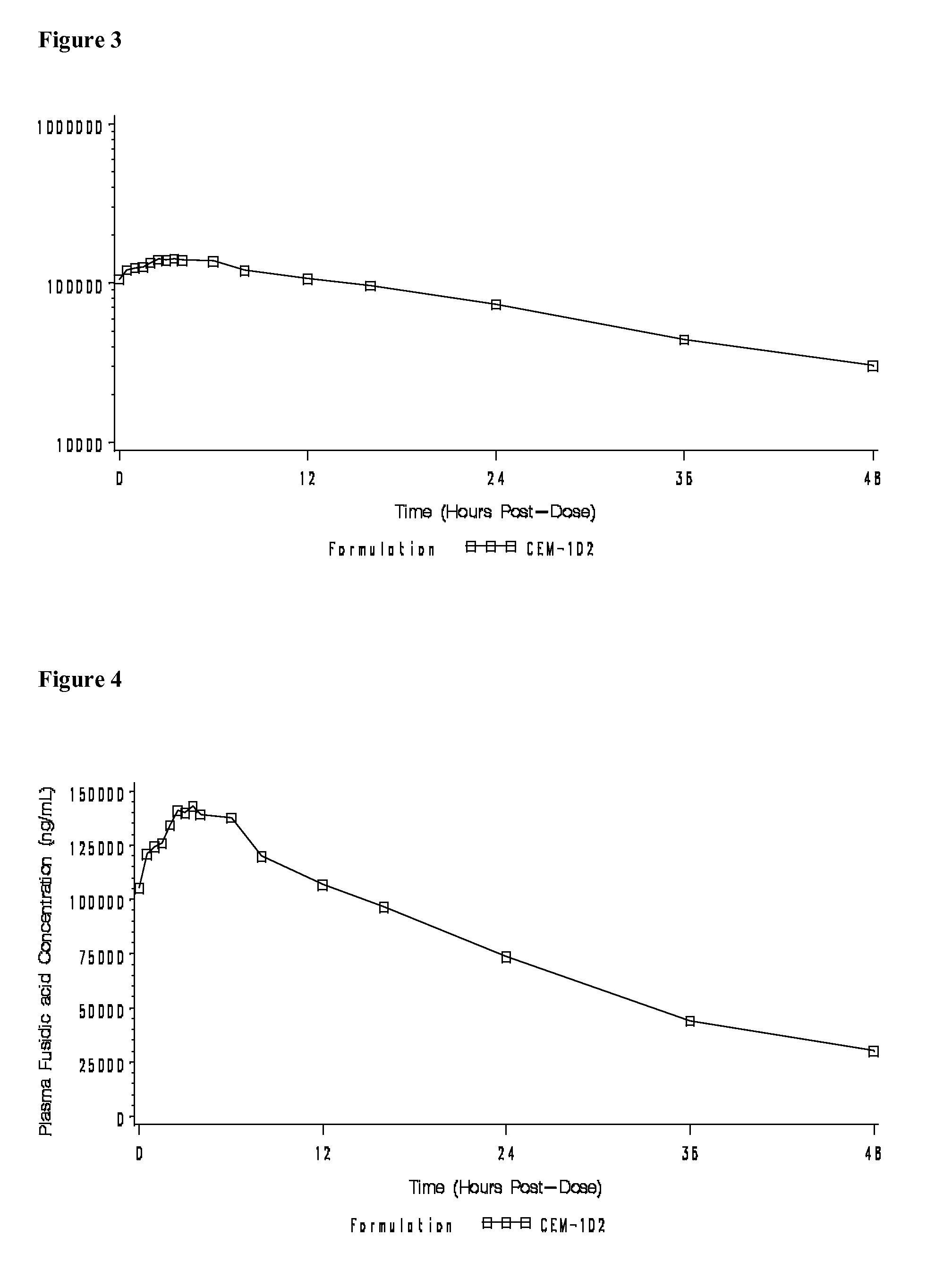Fusidic acid regimens for treatment of bacterial infections
a technology of fusidic acid and bacterial infections, which is applied in the field of fusidic acid regimens for treatment of bacterial infections, can solve the problems of nausea and vomiting in treatment regimens using resistance strains that are not effective against fa, and high doses of fa that are not well tolerated by patients receiving the drug
- Summary
- Abstract
- Description
- Claims
- Application Information
AI Technical Summary
Benefits of technology
Problems solved by technology
Method used
Image
Examples
example 1
Study of the Spectrum of CEM-102 (Fusidic Acid) Against Contemporary Wildtype (WT) Bacterial Species Including Mutational Resistance (R) Analysis, and Synergy Testing
[0132]Methods: A collection of 114 WT isolates (>80 species) was used to define the contemporary limits of CEM-102 (fusidic acid; FA) spectrum against Gram-positive (GP) and -negative (GN) species. CLSI broth microdilution (BMD) and anaerobic agar dilution (AD) methods were performed. Modifications of standard test methods included adding 10% human serum, adjusting the medium pH to 5, 6, and 8, and synergy was assessed by the checkerboard method. Mutational rates to R were determined at 4×, 8× and 16×MIC.
[0133]Results: Against GP, FA MIC values ranged from 0.06-32 μg / ml with greatest potency against S. aureus, Corynebacterium spp. and M. luteus (MIC results 0.25, ≦0.12 and ≦0.5 μg / ml, respectively). Enterococci and streptococci were less susceptible (S; MIC ranges of 2-8 and 16-32 μg / ml, respectively).
[0134]When tested ...
example 2
Antimicrobial Activity of CEM-102 (Fusidic Acid) Against Canadian Isolates of Staphylococci and Streptococci.
[0140]Methods: To determine a contemporary susceptibility (S) spectrum pattern, 153 GP isolates (123 S. aureus, 15 coagulase-negative staphylococci [CoNS] and 15 S. pyogenes [SPYO]) were collected from 5 Canadian medical centers between 2001 and 2006. Reference broth microdilution (BMD) S testing was performed by CLSI M07-A8, 2009 methods for FA and 13 comparator antimicrobials.
[0141]Results: FA MIC results for S. aureus had MIC50 and MIC90 values of 0.12 μg / mL for the 2001-2002 and 2003-2004 time periods, however, for 2005-2006 the MIC90 increased to ≧2 μg / ml (Table 2). Applying an international breakpoint from literature reviews at ≦0.5 μg / ml (S) and ≧2 μg / ml (R), the S. aureus isolates showed a small increase in the R rate over time (5.0-12.2%), now confirmed by 2007-2008 results. The overall S. aureus population had a MIC90 of 0.25 μg / ml and R rate of 8.1%. Some comparato...
example 3
In Vitro Activity of CEM-102 (Fusidic Acid) Against Resistant Strains of Staphylococcus aureus
[0143]The activity of CEM-102 (fusidic acid) against a variety of resistant strains of Staphylococcus aureus was investigated.
[0144]Methods: The in vitro activity of CEM-102 was compared with that of telithromycin, azithromycin, erythromycin, levofloxacin, linezolid, and doxycycline against a total of 145 resistant S. aureus by agar dilution procedures (CLSI, M7-A7, M100-S18). The tested strains included S. aureus MRSA (Mec A genotype; 100 isolates), macrolide-resistant (ermA, B, C genotype or MLSb-resistant; 25), and ciprofloxacin-resistant (gyrA and parC genotype; 20).
[0145]Results: Against S. aureus MRSA (MecA), CEM-102 (MIC90 0.25 mg / L) and telithromycin (MIC90 0.06 mg / L) were more active than doxycycline (MIC90 1 mg / L), linezolid (MIC90 2 mg / L), levofloxacin (MIC90 16 mg / L), azithromycin (MIC90>32 mg / L) and erythromycin (MIC90>32 mg / L). CEM-102 (MIC90 0.25 mg / L) was significantly supe...
PUM
 Login to View More
Login to View More Abstract
Description
Claims
Application Information
 Login to View More
Login to View More - R&D
- Intellectual Property
- Life Sciences
- Materials
- Tech Scout
- Unparalleled Data Quality
- Higher Quality Content
- 60% Fewer Hallucinations
Browse by: Latest US Patents, China's latest patents, Technical Efficacy Thesaurus, Application Domain, Technology Topic, Popular Technical Reports.
© 2025 PatSnap. All rights reserved.Legal|Privacy policy|Modern Slavery Act Transparency Statement|Sitemap|About US| Contact US: help@patsnap.com



